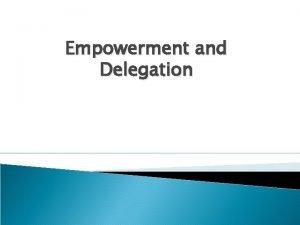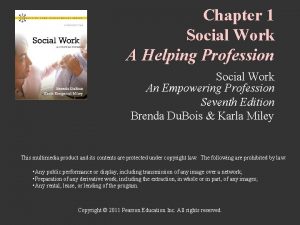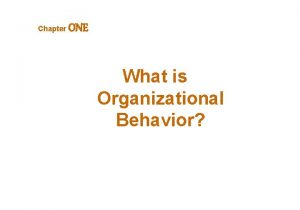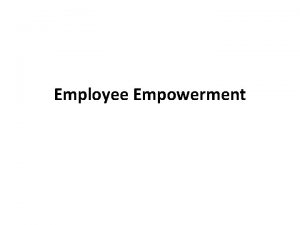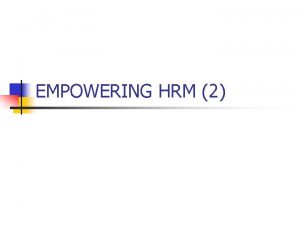Is Empowerment Evaluation Empowering KRISTA COLLINS CLAREMONT GRADUATE












- Slides: 12

Is Empowerment Evaluation Empowering? KRISTA COLLINS CLAREMONT GRADUATE UNIVERSITY NOVEMBER 3, 2011

Agenda 1. Definitions of Participatory v. Empowerment Evaluation 2. Current Empowerment Practice and Guidelines 3. Psychological research on Empowerment Theory 4. Measurement Considerations

Definitions � Participatory Evaluation: the evaluation is conducted through a partnership between the evaluator and program decision-makers (Cousins & Earl, 1995). � Empowerment Evaluation: the use of evaluation concepts, techniques and findings to foster improvement and self-determination (Fetterman, 2001)

Evaluation Processes (Cousins & Whitmore, 1998; Wandersman et al, 2005) Control of Process Diversity of Participants Extent of Involvement Primary Goal Participatory Evaluator leads with stakeholder input Program Staff Participation in all phases Practical • Decision Making • Problem Solving • Evaluation Utilization • Capacity Building • Ownership Empowerment Stakeholder leads with evaluator input Program staff and beneficiaries Participation in all phases Practical • Capacity Building • Organizational Knowledge • Accountability Social/Community Change • Improvement • Community Ownership • Inclusion • Democratic Participation • Social Justice • Community Knowledge • Evidence-Based Strategies

Current Empowerment Practice (Miller & Campbell, 2006) � Disempowered Context Programs target disadvantaged populations Include minority voice � Participatory Activities Collaborative Decision Making Training and Technical Assistance Provide Feedback and Advise � Outcomes Data Use – improvement, decision making Capacity Building – knowledge, skills learned

Challenges �Little distinction between participatory and empowerment activities. �No discussion of how empowerment activities actually link to self-determination. �Examine social science literature for insight on measuring empowerment outcomes �Methodological considerations for measuring empowerment outcomes

Empowerment Theory Empowerment: the perception and active demonstration of self-confidence in one’s ability to create a meaningful change (Rappaport, 1987; Zimmerman, 1995). Empowering Processes 1. Climate 2. Opportunities Psychological Empowerment 1. Self-Efficacy 2. Intrinsic Motivation 3. Locus of Control 4. Prosocial Attitudes Behavioral Empowerment 1. Leadership 2. Advocacy 3. Civic Engagement

Empowering Processes �In addition to participatory activities: decision- making, problem solving and skill building Safe and Supportive Climate Opportunity • • Adult Youth (Spreitzer, 1996) (Cargo et al, 2003; Holden et al 2004) Clear Goals Open Communication Access to Materials Positive Working Relationships • Innovative Thinking • Collaboration • • • Teacher Modeling Step-by-Step Instructions Positive Feedback Safety Feeling Valued • • Leadership Social Skills Critical Reflection Hands-on Learning

Empowering Processes Psychological Empowerment Clear Goals/Expectations Access to Materials (Bandura, 1977) Hands-On Learning Locus of Control Positive Reinforcement (Rotter, 1966) Decision Making Critical Reflection Intrinsic Motivation Collaboration Positive Working Relationships Self-Efficacy (Ryan & Deci, 2000) Prosocial Attitudes

Behavioral Empowerment Behavioral Outputs • # Activities • # Hours • Attendance Behavioral Outcomes • Leadership • Advocacy • Civic Engagement

Measurement Considerations �Long-term outcomes Changes in Attitudes Changes in Behavior �Self-Selection Pre-Post Change �Context Sensitivity Disadvantaged Communities Developmental Trajectory

Thank you! Questions? Contact Information: Krista Collins (Krista. Collins@cgu. edu)
 Harper collins graduate scheme
Harper collins graduate scheme Sakai.claremont
Sakai.claremont Workday claremont colleges
Workday claremont colleges çal
çal Empowering people in ob
Empowering people in ob Empowering the masses
Empowering the masses Empowering minds curriculum
Empowering minds curriculum Empowerment vs delegation
Empowerment vs delegation Social work: an empowering profession 9th edition chapter 1
Social work: an empowering profession 9th edition chapter 1 Basic ob model stage 2
Basic ob model stage 2 Empowering imagination
Empowering imagination Empowering business
Empowering business Empowering the youth quotes
Empowering the youth quotes







